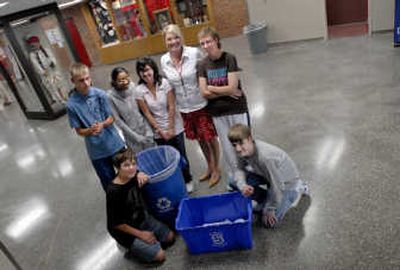It’s never too early to be thinking green

Kids these days. They’ve got the weight of the world – and the atmosphere – on their shoulders.
When it comes to environmental issues, they’re caught between conflicting tensions, says Jennifer Hattam, lifestyle editor for “Sierra” magazine. On one hand, today’s children are hearing more about global warming than youngsters did before them, “so there’s more worry,” she says.
“At the same time, there’s a lot of talk about kids being disassociated from nature, not being able to play outside,” Hattam says, raising the question of whether tomorrow’s leaders will feel connected enough to the planet to care for it.
There are steps children can take, though, to protect the environment, especially as they head back to school. And there are ways that families can help foster a sense of environmental responsibility in youngsters.
Re-use it
While some people might give up on being green because they can’t afford to buy hybrid cars or install solar panels in their roofs, Ann Murphy, education coordinator for the Spokane Regional Solid Waste System, says there are plenty of ways to save energy and money at the same time.
Some of her personal conservation habits were born out of financial necessity when her children were young.
“You don’t always have money to buy everything new,” says Murphy, advising people to shop at secondhand stores for school clothes and backpacks. “Some things get passed on without much wear.”
She also suggests visiting www.2good2toss.com, a Web site serving Washingtonians where people can buy and sell used items. The site is divided by county, and organized into categories such as school supplies, sporting goods and children’s items.
Share the road
For families without bus service, Murphy recommends organizing neighborhood carpools to get children to and from school.
Better yet, encourage students to walk or ride their bicycles, if they live close enough.
“Kids used to walk to school more, and they just don’t do that any more,” she says.
Less waste at lunch
The lunch hour is one of the most wasteful times of the school day, says Hattam. Making lunches for school creates an average of 67 pounds of garbage per child, or more than 18,000 pounds per school, each year, the Sierra Club says.
Today’s busy schedules mean families often rely on pre-packaged, single-serving snacks when preparing lunches. Companies heavily market those products to children, and studies have shown that kids actually believe food packaged individually tastes better – adding to the pressure that families feel to buy those products.
“I think that convenience has become enshrined in consumers’ minds as a high priority,” Hattam says. Most packaged treats “really aren’t that healthy anyway, but we’ve come to see convenience as the virtue above all others.”
A more Earth-friendly sack lunch would contain food – preferably organic food – prepared at home or food bought in bulk and then divided among family members.
And speaking of sacks, why not buy a few reusable lunch bags or boxes rather than hundreds of paper bags that end up in the trashcan by half past noon each day?
Families also should avoid buying disposable water or juice bottles, since the plastic from many of those products has been shown to leach toxins into the drinks, Hattam says. The safest plastics are labeled No. 1, 2, 4 or 5, but Hattam recommends families buy reusable beverage containers from companies such as Sigg or Klean Kanteen, which make alumninum- and stainless steel-lined reusable bottles, instead.
Paper cuts
Consumers buy 3.4 million tons of paper during the back-to-school season, according to the Sierra Club.
“Paper use is huge throughout society,” Hattam says. “Computers haven’t really helped us reduce our paper (use), but more vendors are selling recycled paper.”
Look for products labeled “100 percent recycled” and take seemingly small steps – such as writing on both sides of a page and printing out only what you need – to save some trees, Hattam says.
North Central High School science teacher Brent Osborn, who organizes a program in which students work with the Washington state Department of Natural Resources researching dangers to local native habitats, suggests students use spiral notebooks or composition books instead of loose-leaf paper when they can.
“Kids seem more free to rip out and waste loose paper as opposed to paper that is in a notebook,” he says.
Osborn also often sends students to the recycle bin when they need scrap paper for in-class tasks.
Product push
As the green lifestyle has entered the nation’s consciousness, an explosion of related products have followed.
Some school-related items include EarthWrite recycled pencils and PVC-free backpacks made from recycled materials. There even are backpacks today with solar-powered iPod chargers built into the fabric lining. Visit www.solio.com for more solar-powered devices.
“There are some green products that are cool, stylish and fun,” Hattam says. While they won’t save the planet on their own, “they make green things more visible and popular,” she says.
With so many snazzy products available, is it hip for kids to be green today?
“I’m not a good measure of what cool is, but I would say that being green is not unusual,” says Osborn.
While Earth friendliness isn’t pervasive at his school, he says students are more aware of environmental concerns than when he was a pupil in the late 1980s and early ‘90s. Whether they all understand the science behind the issues, Osborn’s not sure, but he says they’re getting the green message from movies, actors and the media.